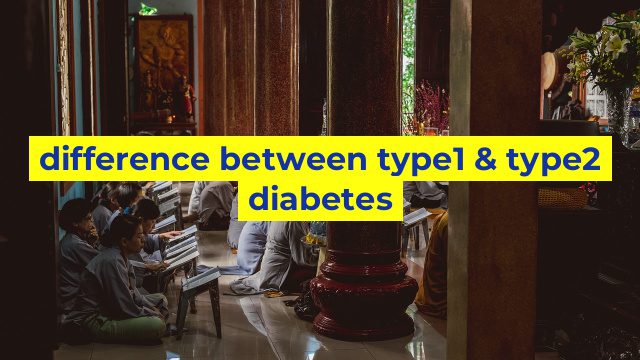Difference between Type 1 & Type 2 Diabetes
Diabetes is a metabolic disorder that affects the way your body uses glucose, which is used as a source of energy for your body. There are two types of diabetes, type 1 and type 2, which differ in their causes, symptoms, and treatments.
Causes
Type 1 diabetes is an autoimmune disease that occurs when the immune system attacks and destroys the insulin-producing beta cells in the pancreas. This results in a lack of insulin production, which in turn leads to high blood sugar levels.
Type 2 diabetes, on the other hand, is caused by a combination of factors, including genetics, lifestyle, and environmental factors. It occurs when your body becomes resistant to insulin, or when your pancreas is not able to produce enough insulin to regulate your blood sugar levels.
Symptoms
The symptoms of type 1 and type 2 diabetes are similar, but they can be more severe in type 1 diabetes. Symptoms of diabetes include:
– Frequent thirst and urination
– Fatigue and weakness
– Blurred vision
– Slow healing of wounds
– Weight loss (in type 1 diabetes)
– Weight gain (in type 2 diabetes)
Treatments
The treatments for type 1 and type 2 diabetes are different. Type 1 diabetes is typically treated with insulin injections or an insulin pump, as the body does not produce any insulin on its own. Type 2 diabetes can be treated with lifestyle changes, such as diet and exercise, as well as medications that help lower blood sugar levels.
In conclusion, while both types of diabetes share similar symptoms, they have distinct causes and treatments. Understanding the differences between type 1 and type 2 diabetes can help you better manage your diabetes and live a healthier life.
Table difference between type1 & type2 diabetes
| Type of Diabetes | Description | Causes | Symptoms | Treatment |
|---|---|---|---|---|
| Type 1 Diabetes | Also called insulin-dependent diabetes or juvenile-onset diabetes, Type 1 diabetes is an autoimmune disease that occurs when the body cannot produce insulin on its own. | Unknown, but may involve genetics and environmental factors. | Increased thirst and hunger, frequent urination, fatigue, sudden weight loss, blurred vision, and slow-healing wounds and infections. | Insulin therapy, blood sugar monitoring, healthy eating, and regular exercise. |
| Type 2 Diabetes | Also called non-insulin dependent diabetes or adult-onset diabetes, Type 2 diabetes is a chronic condition in which the body becomes resistant to insulin or doesn’t produce enough insulin on its own. | Obesity, genetics, age, inactivity, and poor diet. | Frequent urination, increased thirst and hunger, blurred vision, slow-healing wounds and infections, and tingling or numbness in the hands or feet. | Healthy eating and lifestyle changes, blood sugar monitoring, oral medications, and in some cases, insulin therapy. |

